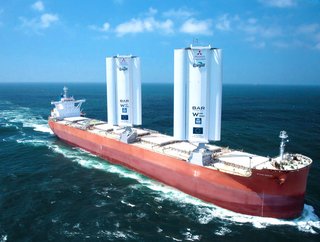Choppy waters for sea shipping on clean fuel journey

The sea shipping sector is involved in an estimated 90% of global trade. Estimates from the International Chamber of Shipping suggest around 11bn tons of goods are transported by sea each year – everything from raw materials to finished products.
Sea shipping also accounts for around 3% of total global carbon emissions, which if unchecked could rise by as much as half again by 2050.
In short, shipping industry efforts to implement a programme of carbon-cutting measures is pivotal to the global bid to be net zero by 2050.
This is why the International Maritime Organization (IMO) – a specialised agency of the United Nations responsible for regulating shipping – has mandated emission reductions of 50% for all vessels by 2050. A number of countries, including Japan, the UK and the US, have also set similar net-zero shipping targets.
But progress is proving to be far from plain sailing, with recent top-level talks to tackle greenhouse gas (GHG) emissions in the maritime transport industry slammed by environmentalists as “disheartening” and “tepid”.
Those comments followed the 80th session of the Marine Environment Protection Committee (MEPC), held in London in July at the London HQ of the IMO.
The talks focused on the adoption by the IMO of an upgraded greenhouse gas strategy, and involved delegates from 175 shipping countries, all of whom are looking to set a timeline for decarbonising their industry.
The outcome of those talks was that the IMO set a revised target of a 10% reduction of GHG by 2030, with the earliest measures to achieve this not being put in place until 2027.
Diane Gilpin is Founder and CEO of Smart Green Shipping, a company that is unlocking wind power for the shipping industry.
"It's difficult not to be disheartened by the outcome of the IMO talks,” Gilpin says “Science tells us that anything less than 36% emissions reductions by 2030 and 96% by 2040 will be detrimental to keeping global warming below 1.5 degrees.”
She points out that emissions in the shipping industry have consistently risen since the first UN climate conference held back in 1979.
She says: “The industry has been calling for a level playing field and clarity through regulation but it's simply not happening because there are so many conflicts of interest.
“The technologies already exist and it's positive to see ship operators starting to harness them to future proof their assets. Those that act now stand to reap significant financial and reputational benefits."
Gilpin adds: “The fact 40% of shipping trade is fossil fuels speaks for itself. We do not have the time to wait for regulation or alternative fuels to catch up. We need to move with urgency and work with what we have. Wind is the obvious solution – it's abundant, freely available, saves costs and drives down emissions.”
Gilpin’s insistence that wind power is one answer to the sea freight fuels issue comes at a time when cutting-edge wind propulsion technology is being tested by sea freight carriers for the first time.
The wind energy pilot is a collaboration between multinational food company Cargill, BAR Technologies, Mitsubishi Corporation and Yara Marine Technologies, and if successful could decarbonise cargo vessels by up to 30%
Mitsubishi Corporation’s vessel Pyxis Ocean has been chartered by food giant Cargill, and is the first to be fitted with ‘WindWings’, which are wing sails 37.5 metres high that can be fitted to the deck of cargo ships to harness the wind.
Jan Dieleman, Ocean Transportation Business Leader at Cargill, says: “The maritime industry is on a journey to decarbonise. It's not an easy journey but it is an exciting one.
“We have a responsibility to pioneer decarbonising solutions across all our supply chains to meet customer needs and the needs of the planet.
“A technology like WindWings doesn’t come without risk, and as an industry leader we are not afraid to invest, take those risks and be transparent with our learnings to help our partners in maritime transition to a more sustainable future.”
Clearly, wind power is one for the future. But what about the present? What other carbon-reducing measures can be taken by the sea freight industry?
Alex Hersham is CEO of Zencargo, a digital freight forwarder and logistics provider.
Referring to IMO regulations around cleaner fuels, Hersham says carriers face a choice, particularly around older vessels: either switch to cleaner and more expensive biofuels or simply slow down, to cut down on fuel consumption.
“With new capacity entering the market, many carriers might choose to retire older vessels rather than maintain inefficient operations,” he says.
Hersham also points out the IMO is not forcing vessels to comply until 2024, and that it will not prevent non-compliant vessels from sailing until 2025.
“This means any scrapping or idling of ships for the next two years is at the carriers’ discretion,” he says.
In terms of what the new regulations will mean for sea freight prices, Hersham feels that shipping companies “might eventually increase the cost of sea freight to help pay for new energy efficient technologies and fuels that comply with IMO requirements.
Having endured some of the highest ever sea shipping rates over the past three years, it remains to be seen how customers will react to such a price hike, especially as they have only recently begun benefitting from a return to pre-pandemic shipping rates.”
Despite these challenges, Hersham feels the pace of change in sustainable sea freight is “encouraging”.
“We’re already seeing a shift to more-sustainable shipping,” he says. “This is reflected in the carriers’ order books for more dual-fuel ships, which are beginning to make up a greater proportion of new vessels.”
He adds: “There is great potential for investment in biofuels. Some biofuels, such as dimethyl ether, require no extensive modifications to engines, and are the most ready low-emissions fuel option.”
But, he adds, these are also “substantially more expensive than traditional fuels”, and that there are doubts such fuel “can be consistently produced in the required quantities”.
However sustainable shipping plays out over the coming years, Hersham says that supply chain executives must prepare for change by “speaking to their partners in order to understand how the new regulations will affect capacity, lead times and schedule reliability”.







